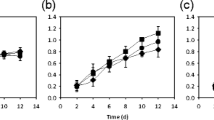Abstract
The effect of light intensity (50–300 μmol photons m−2 s−1) and temperature (15–50°C) on chlorophyll a, carotenoid and phycobiliprotein content in Arthronema africanum biomass was studied. Maximum growth rate was measured at 300 μmol photons m−2 s−1 and 36°C after 96 h of cultivation. The chlorophyll a content increased along with the increase in light intensity and temperature and reached 2.4% of dry weight at 150 μmol photons m−2 s−1 and 36°C, but it decreased at higher temperatures. The level of carotenoids did not change significantly under temperature changes at illumination of 50 and 100 μmol photons m−2 s−1. Carotenoids were about 1% of the dry weight at higher light intensities: 150 and 300 μmol photons m−2 s−1. Arthronema africanum contained C-phycocyanin and allophycocyanin but no phycoerythrin. The total phycobiliprotein content was extremely high, more than 30% of the dry algal biomass, thus the cyanobacterium could be deemed an alternative producer of C-phycocyanin. A highest total of phycobiliproteins was reached at light intensity of 150 μmol photons m−2 s−1 and temperature of 36°C, C-phycocyanin and allophycocyanin amounting, respectively, to 23% and 12% of the dry algal biomass. Extremely low (<15°C) and high temperatures (>47°C) decreased phycobiliprotein content regardless of light intensity.




Similar content being viewed by others
References
Allen MB, Arnon DJ (1955) Studies on nitrogen-fixing algae. I. Growth and nitrogen fixation by Anabaena cylindrica Lemm. Plant Physiol 30:366–372
Belay A, Ota Y, Miyakawa K, Shimamatsu H (1993) Current knowledge on potential health benefits of Spirulina. J Appl Phycol 5:235–241
Critchley C (1988) The molecular mechanism of photoinhibition - facts and fiction. Aust J Plant Physiol 15:27–41
Dilov C (1985) Mass cultivation and use of microalgae. Bulgarian Academy of Sciience Publishing House
Foyer CH, Lelandais M, Kunert KJ (1994) Photooxidative stress in plants. Physiol Plant 92:696–717
Furnadzieva S, Pilarski P, Andreeva R (1999) Phycobiliproteins in the cyanobacterium Arthrospira, depending on kind, nitrogen nutrition, temperature and light intensity. In: Abstract of the conference “Achievements and prospectives of physiology and biochemistry of plant nutrition”, Institute of Plant Physiology, BAS, Sofia, 16 September 1999, pp 45–49
Grossman A, Schaefer M, Chiang G, Coller J (1993) Environmental effects on the light-harvesting complex of cyanobacteria. J Bacteriol 175:575–582
Hancock M (1997) Potential for colourants from plant sources in England and Wales. ADAS Boxworth, Cambridge
Henriksen P (1996) Microcystin profiles and content in Danish populations of cyanobacteria /blue-green algae as determined by HPLC. Phycologia 35 (Suppl 6):102–110
Hudson R (1990) Iron transport in marine phytoplankton. Limnol Oceanogr 35:1002–1020
Kirk JTO (1994) Light and photosynthesis in aquatic systems. Cambridge University Press, Cambridge
Komárek J, Lukavský J (1988) Arthronema, a new cyanophyte genus from Afro-Asian deserts. Arch Hydrobiol/Algolog Stud 50–63:249–267
Kopecky I, Schoeps B, Loest K, Stys D, Pulz O (2000) Microalgae as a source for secondary carotenoid production: a screening study. Arch Hydrobiol/Algolog Stud 36:153–168
Kowalewska G, Szymczak M (2001) Influence of selected abiotic factors on the decomposition of chlorophylls. Oceanologia 43:315–328
McKinney G (1941) Absorption of light by chlorophyll solutions. J Biol Chem 140:315–322
Mihova S, Georgiev D, Minkova K, Tchernov A (1996) Phycobiliproteins in Rhodella reticulata and photoregulatory effect of their content. J Biotechnol 48:251–257
Minkova K, Tchernov A, Tchorbadjieva M, Fournadzhieva S, Antova R, Busheva M (2003) Purification of C-phycocyanin from Spirulina (Arthrospira) fusiformis. J Biotechnol 102:55–59
Mur R (1983) Some aspects of the ecophysiology of cyanobacteria. In: Ann Microbiol (Paris). Jul-Aug 134B (1): pp 61–72
Olaizola M, Duerr E (1990) Effects of light intensity and quality on the growth rate and photosynthetic pigment content of Spirulina platensis. J Appl Phycol 2:97–104
Raven J, Handley L, Andrews M (2004) Global aspects of C/N interactions determining plant-environment interactions. J Exp Bot 55:11–25
Reynolds CS (1984) The ecology of freshwater phytoplankton. Cambridge University Press, London
Richmond A (1986) Cell response to environmental factors. In: Richmond A (ed) Handbook of Microalgal Mass Culture. CRC Press, Boca Raton, Fla, p 69–99
Rimbau V, Camins A, Romay C, González R, Pallàs M (1999) Protective effects of C-Phycocyanin against kainic acid-induced neuronal damage in rat hippocampus. Neurosci Lett 276:75–78
Robards R, Zohary T (1987) Temperature effects on photosynthetic capacity, respiration and growth rates of blocm-forming cyanobacteria. N Z J Mar Freshwater Res 21:391–399
Romay C, Gonzalez R, Ledon N, Remirez D, Rimbau V (2003) C-Phycocyanin: a biliprotein with antioxidant, anti-Inflammatory and neuroprotective effects. Curr Protein Pept Sci 4:207–216
Siegelman HW, Kycia JH (1978) Algal biliproteins. In: Hellebust JEA, Craisie JS (eds) Handbook of Phycological Methods. Cambridge Univ. Press, Cambridge, pp 71–79
Staub R (1961) Ernahrungsphysiologisch-autokologische Untersuchungen an der planktischen Blaualge Oscillatoria rubescens DC. Schweiz Z Hydrol 23:83–198
Straus NA (1994) Iron deprivation: physiology and gene regulation. In: Bryant DA (ed) The Molecular Biology of Cyanobacteria. Kluwer, Dordrecht, pp 731–750
Tang E, Vincent W (1999) Strategies of thermal adaptation by high-latitude cyanobacteria. New Phytol 142:315–323
Telford W, Moss M, Morseman J, Allnutt T (2001) Cryptomonad algal phycobiliproteins as fluorochromes for extracellular and intracellular antigen detection by flow cytometry. Cytometry 44:16–23
Tilzer M (1987) Light-dependence of photosynthesis and growth in cyanobacteria: implications for their dominance in eutrophic lakes. N Z J Mar Freshwater Res 21:401–412
Acknowledgements
We thank projects “Progress in plant investigations for improvement of the sustainability of agriculture” (PISA) INI–14/05.09.2005 of Inst. Plant Physiol., financed by the Ministry of Education and Science of the Republic of Bulgaria, also the Ministry of Education of the Czech Republic, project 1M 6798593901, and the Academy of Sciences of the Czech Republic AVO Z60050516 for their financial support, V. Pavlova and P. Babica for the cyanotoxins analysis, V. Titlová for her technical assistance, V. O. Cepák for his many valuable comments, and last, but not least, I.Šetlík for the sample.
Author information
Authors and Affiliations
Corresponding author
Rights and permissions
About this article
Cite this article
Chaneva, G., Furnadzhieva, S., Minkova, K. et al. Effect of light and temperature on the cyanobacterium Arthronema africanum - a prospective phycobiliprotein-producing strain. J Appl Phycol 19, 537–544 (2007). https://doi.org/10.1007/s10811-007-9167-6
Received:
Accepted:
Published:
Issue Date:
DOI: https://doi.org/10.1007/s10811-007-9167-6




